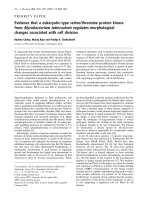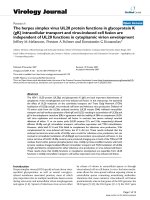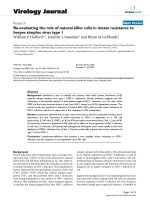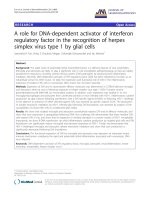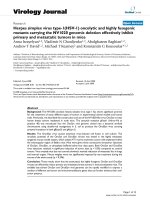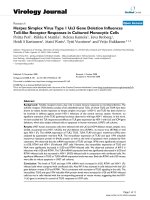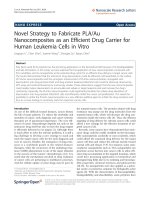Báo cáo y học: "Subacute herpes simplex virus type 1 encephalitis as an initial presentation of chronic lymphocytic leukemia and multiple sclerosis: a case report" doc
Bạn đang xem bản rút gọn của tài liệu. Xem và tải ngay bản đầy đủ của tài liệu tại đây (2.54 MB, 7 trang )
CASE REP O R T Open Access
Subacute herpes simplex virus type 1 encephalitis
as an initial presentation of chronic lymphocytic
leukemia and multiple sclerosis: a case report
Rashi L Singhal
*
, Lourdes C Corman
Abstract
Introduction: Herpes simplex virus type 1 encephalitis presents acutely in patients who are immunocompetent.
We report on what we believe to be the first published case of a subacute course of herpes simplex virus type 1
encephalitis in a patient with asymptomatic chronic lymphocytic leukemia who subsequently developed multiple
sclerosis.
Case presentation: A 49-year-old Caucasian woman with a history of fever blisters prese nted to our emergency
department with a history of left temporal headache for four weeks, and numbness of the left face and leg for two
weeks. A complete blood count revealed white blood cells at 11,820 cells/mL, with absolute lymphocytes at 7304
cells/mL. The cerebrospinal fluid contained 6 white blood cells/μL, 63 red blood cells/μL, 54 mg glucose/dL, and
49 mg total protein/dL. Magnetic resonance imagi ng of the brain revealed meningoencephalitis and bilateral
ventriculitis. Cerebrospinal fluid polymerase chain reaction for herpes simplex virus type 1 was positive, and our
patient’s symptoms resolved after ten days of treatment with parenteral aciclovir. Incidental findings on peripheral
blood smear and flow cytometry testing confirmed chronic lymphocytic leukemia. Then, one month later, she
developed bilateral numbness of the hands and feet; a repeat cerebrospinal fluid polymerase chain reaction for
herpes simplex virus type 1 at this time was negative. A repeat magnetic resonance imaging scan showed an
expansion of the peri-ventricular lesions, and the cerebrospinal fluid contained elevated oligoclonal bands and
myelin basic protein. A brain biopsy revealed gliosis consistent with multiple sclerosis, and our patient responded
to treatment with high-dose parenteral steroids.
Conclusion: Herpes simplex virus type 1 encephalitis is a rare presentation of chronic lymphocytic leukemia. Our
patient had an atypical, subacute course, presumably due to immunosuppression from chroni c lymphocytic
leukemia. This unusual case of herpes simplex virus type 1 encephalitis emphasizes the importance of T cell
function in diseases of immune dysregulation and autoimmunity such as chronic lymphocytic leukemia and
multiple sclerosis. It raises the question of whether atypical presentations of herpes simplex virus encephalitis
warrant deliberations on immunocompetence. The development of multiple sclerosis in our patient so soon after
she received treatment for herpes simplex virus type 1 encephalitis raises the possibility that herpes simplex virus
type 1 encephalitis in patients who are immunosuppressed may trigger multiple sclerosis.
Introduction
Herpes simplex virus type 1 (HSV-1) encephalitis is the
most common cause of adult encephalitis worldwide. It
classically occurs in patients un der the age of 20 years
due to primary infection, or in patients over the age of
50 years due to rea ctivation of latent infection. It is
thought to occur sporadically in patients who are immu-
nocompet ent at the same rate as it does in patients who
are immunocompromised [1].
HSV-1 encephalitis usually presents acutely, with gen-
eral and focal signs of cerebral dysfunction such as fever,
headache, altered mental status, behavioral changes, con-
fusion, seizures, focal neurological findings, and abnor-
mal cerebrospinal fl uid (CSF) findings. The CSF of
patients with HSV-1 encephalitis typically demonstrate s
* Correspondence:
The University of Alabama at Birmingham, Huntsville, Alabama, USA
Singhal and Corman Journal of Medical Case Reports 2011, 5:59
/>JOURNAL OF MEDICAL
CASE REPORTS
© 2011 Singhal and Corman; licensee BioMed Central Ltd. This is an Ope n Access article distributed under the terms of the Creative
Commons Attribution License ( y/2.0), which permits unrestricted use, distribut ion, and
reproduction in any medium, provided the or iginal work is properly cited.
a lymphocytic pleocytosis (white blood cells (WBC): 10 to
500 cells/μL), and erythrocytosis (red blood cells (RBC):
10 to 500 cells/μL). Levels of protein may be elevated to
60 to 700 mg/dL, and levels of glucose may be normal or
slightly decreased (30 to 40 mg/dL).
Imaging of the brain with magnetic resonance imaging
(MRI) classically demonstrates high signal intensity of
the temporal lobe. Electroencephalography (EEG) results
may show focal temporal abnormalities, such as spikes
and slow waves or periodic sharp wave patterns. A diag-
nosis of HSV encephalitis is confirmed with identifica-
tion of HSV in the CSF via polymerase chain reaction
(PCR) testing or, less commonly, with identification of
HSV in brain tissue via biopsy.
It is well established that patients with defects in cell-
mediated immunity are at increased risk of severe oral
or genital HSV infection; however, an increased fre-
quency of HSV meningoencephalitis has not been
reported. We report a subacute course of HSV-1 menin-
goencephalitis in a patient with undiagnosed chronic
lymphocytic leukemia (CLL), who presented with
biopsy-proven multiple sclerosis (MS) shortly after
receiving treatment for HSV-1 encephalitis.
Case presentation
A 49-year-old Caucasian woman with a history of
migraines and herpes labialis presented to our emer-
gency department (ED) with headache, and numbness
and tingling in the left si de of the face and her left leg.
She related a history of recurrent sinusitis related to sea-
sonal allergies, but with no recent nasal or pulmonary
symptoms. She had developed peri-oral fever blisters, a
low-grade fever, and a disabling left temporal headache
four weeks earlier. Her headache was unlike the typical
migraines that she periodically experienced, which
usually responded to a combination of acetaminophen,
aspirin, and caffeine. In addition, she experienced nau-
sea, vomiting, and decreased appetite in association with
her headaches that were accompanied by a 7.7 kg weight
loss. She also exhibited personality changes and short-
term memory loss. Her blisters healed in two weeks, but
her headache and fatigue persisted. She subsequently
developed numbness and subjective weakness in the left
side of her face and her left leg one week prior to pre-
sentation. She sought care from her primary care provi-
der, who diagnosed her with B ell’s palsy and prescribed
metoclopramide for her nausea. She was also referred to
a neurologist who began treatment with aspirin for sus-
pected transient ischemic attack. An MRI of the brain
was pending at the time of her presentation to the ED.
On admission, our patient’ s temperature was 37.9°C,
blood pressure 166/96 mmHg, pulse rate 89 beats/min-
ute, respiration rate 18 breaths/minute, and oxygen
saturation 97.5% on room air. Her mental status and
affect were normal. The distribution of dysesthesias was
confirmed to be in the V2/V3 and L4/L5 d ermatomes
on physical examination. No motor deficits, other neu-
rological abnormalities, or lymphadenopathy were
noted. A basic metabolic panel was remarkable for
3.2 mEq potassium/L (normal range 3.5 to 5.0). A com-
plete blood count revealed 11.82 × 10
9
cells/ L for WBC,
with 7.304 × 10
3
cells/μL for absol ute lymphocytes. Her
CSF was clear and contained WBC: 6 cells/μL (89% lym-
phocytes), RBC: 63 cells/μL, 54 mg glucose/dL, and
49 mg total protein/dL; cell counts were taken from the
fourth tube of CSF collected. Results of a chest radio-
graph were normal, and an MRI scan of the brain
showed left greater than right ventriculitis, basal menin-
gitis, and encephalitis of the peri-ventricular and right
basal ganglia white matter (see Figure 1).
Treatment with intravenous dexamethasone, ceftriax-
one, and aciclovir was initiated and the low potassium
was replaced. Our patient’s headache and dysesthesias
rapidly improved. On day 2, the hospital’s pathology lab
reported small, mature-appearing lymphocytes and
smudge cells in her peripheral blood smear. Further
immunological investigation revealed 259 absolute
CD4+ T cells (normal range 400 to 1500), 389 absolute
CD8+ T cells (normal range 275 to 780), and a CD4/
CD8 ratio of 0.7 (normal range 0.9 to 3.7). Results of a
CSF polymerase chain reaction (PCR) test for HSV-1
were positive, and results of serum HIV-1 and 2 anti-
body tests were negative. Ceftriaxone and dexametha-
sone were subsequently discontinued. The serum and
CSF studies performed to rule out other infectious and
vasculitic processes are listed in Table 1.
A diagnosis of CLL was confirmed by the expression
of CD5, CD19, and CD20 antigens on monoclonal B
cells with light chain restriction on blood flow cyto-
metry. Fluorescent in situ hybridization later revealed a
13 q deletion, the most common cytogenetic abno rmal -
ity seen among patients with CLL. Our patient’ s
g- glob uli n level was 839 mg/dL (normal range 700 to
1600). After eight days on intravenous aciclovir, her symp-
toms had completely resolved and she was discharged on
oral valaciclovir. She remained well for the next few weeks.
Then, one month after discharge, she developed new
bilat eral numbness of the hands and feet and was found
to have cervical lymphadenopathy on physical examina-
tion. A repeat MRI showed increased numbers and size
of peri-ventricular lesions (see Figure 1), and she was
readmitted. A repeat CSF PCR test for HSV-1 was nega-
tive, but 10 oligoclonal bands and a myelin basic protein
level of 5.7 ng/mL (normal va lue <1.5) were found.
Table 2 gives details of the other laboratory test results
for comparison between our patient’s first and second
admissions. Computed tomography (CT) scans revealed
extensive cervical lymphadenopathy, slightly enlarged
Singhal and Corman Journal of Medical Case Reports 2011, 5:59
/>Page 2 of 7
axillary nodes bilaterally, and early lymphadenopathy
among the mesentery. A brain biopsy was performed to
rule out CNS lymphoma, and it demonstrated gliosis
consistent with MS with no evidence of lymphoma (see
Figure 2). She received high-dose parenteral steroids for
five days, with symptom resolution occurring within the
first two to three days. She was discharged on oral predni-
sone treatment and followed up by her neurologist and
oncologist. At six months later our patient was still asymp-
tomatic, having started interferon-b therapy for MS and
not yet needing treatment for Rai stage zero CLL.
Discussion
HSV-1 encephalitis usually presents fulminantly in immu-
nocompetent individuals with fever, altered mental status,
seizures, CSF and EEG findings, and temporal lobe lesions
on MRI. Our patient’s illness began with recurrent herpes
simplex labialis, which spread to the left trigeminal nerve
and left L5 nerve root over the course of four weeks.
Besides her dysesthesias, her symptoms included head-
ache, low-grade fever, weight loss, mild personality change
andshort-termmemoryloss,whichwerenolongerexhib-
ited on presentation. Her CSF contained mildly elevated
levels of lymphocytes (WBC: 6 cells/μL) , erythrocyt es
(RBC: 63 cells/μL), and protein (49 mg/dL); owing to the
fact that cell counts were taken from the fourth tube col-
lected, the probability of a traumatic lumbar puncture is
low. Beyond her MRI findings of peri-ventriculitis and
basal meningitis, particularly over the brainstem, our
patient had no temporal lobe abnormalities, although
approximately 10% of patients with PCR-proven HSV
encephalitis do not demonstrate temporal lobe involve-
ment. In addition, other cases of bra inst em en cephaliti s
due to HSV have been reported with viral reactivation
possibly occurring in the trigeminal nerve (relevant refer-
ences are available upon req uest from the corresponding
author). Regarding involvement of white matter, other
cases of extratemporal HSV encephalitis have also shown
this pattern on neuroimaging, particularly during chronic
or subacute phases of illness, often being associated with
clinical relapse and viral persistence and sometimes show-
ing demyelination in addition to edema, inflammatory
change, and viral inclusions on a microscopic level (rele-
vant references are available upon request from the
author). Overall, our patient’s clinical presentation, bor-
derline pleocytosis in the CSF, and extratemporal findings
on MRI were consistent with a more subacute course of
HSV-1encephalitisprovenbyPCR,presumablydueto
immunosuppression from CLL.
Patients with CLL often manifest hyp o-g-globuline-
mia and neutropenia early in the course of the disease,
with eventual T cell deficiency leading t o recurrent
sinopulmonary infections with Gram-negative bacteria,
fungi, and herpes zoster and simplex viruses. However,
HSV-1 encephalitis is a rare presentation of CLL.
Other central nervous system (CNS) infections have
Figure 1 Comparison of brain MRIs between patient’s first (A) and second (B ) admission. A) Axial T2-flair MRI from 2 February 2009
demonstrating foci of peri-ventricular hyperintensity (more evident on the left than the right). Other findings included left greater than right
lateral ventriculitis, basal meningitis, encephalitis involving the peri-ventricular and right basal ganglia white matter, and enhancing lesions in the
left pons and the lower third of the medulla. B) Axial T2-flair MRI from 9 March 2009 demonstrating enlargement of prior hyperintense foci and
new hyperintensity in the right posterior peri-ventricular white matter. Other findings included new enhancing lesions in the splenium of the
corpus callosum, decreased enhancement in the right corona radiata and left frontal horn, and unchanged enhancements in the pons and
medulla.
Singhal and Corman Journal of Medical Case Reports 2011, 5:59
/>Page 3 of 7
been reported in patients with CLL, namely progressive
multifocal leukoencephalopathy, West Nile virus ence-
phalitis, and Listeria monocytogenes encephalitis. The
occurrence of HSV-1 encephalitis in patients who are
immunocompromised has rarely been reported. Classic
clinical presentations with atypical laboratory studies
have been described in a patient with metastatic colon
cancer four w eeks after receiving chemotherapy [2],
three patients who were immunosuppressed with
either Hodgkin’ sornon-Hodgkin’s lymphoma [3-5],
and another patient with glioblastoma multiforme on
dexamethasone [5]. Atypical clinical presentations of
HSV encephalitis have been described in patients
receiving steroids, and also occur in 2% of patients
with human immunodeficiency virus (HIV) with neu-
rological symptoms, usually in association with CD4 T
cell counts <200 cells/μ L[6].
The literature exploring the association of MS with
CLL is very limited. Neither the development of CLL
prior to the development of MS, nor the rever se, have
been shown to have an association in retr ospective stu-
dies ([7]; additional references are available upon request
from the author). Only one study has shown an
increased risk of Hodgkin’ s and non- Hodgkin’ slym-
phoma in first-degree relatives of patient s with MS, and
this is thought to be related to shared environmental
and constitutional factors such as infection with
Epstein-Barr virus or expression of the HLA-DR2 allele.
The development of clinical symptoms and signs of
MS in our p atient so soon after her episode of HSV-1
encep halitis, as well as her earlier atypical peri-ventricu-
lar pattern of MRI findings, suggests a possible associa-
tion between the infe ction and subsequent diagnosis of
MS. On the o ne hand, it is possible that our patient’s
Table 1 Results of infectious and vasculitic and neoplastic studies performed on patient’s first admission
Serum studies Result (normal
range or value)
CSF studies Result (normal range)
Ehrlichia Ab titers
Anaplasma phagocytophilum IgG <1:64 (<1:64) Aerobic/anaerobic
culture with Gram
stain
No organisms seen, no growth
at 3 days
Ehrlichia chaffeensis IgG <1:64 (<1:64)
Bartonella Ab titers
Bartonella henselae IgG and IgM <1:128 and <1:20
(<1:128 and <1:20)
Fungal preparation
and culture
No fungal elements seen, no
fungus recovered at 4 weeks
Bartonella quintana IgG and IgM <1:128 and <1:20
(<1:128 and <1:20)
Lyme disease antigen PCR Negative AFB culture with
smear
No AFB seen, no AFB
recovered at 8 weeks.
RPR Non-reactive VDRL Negative
Viral hepatitis panel
HA Ab (IgM) Non-reactive
HBcAb (IgM) and HBsAg Non-reactive CMV PCR Negative
HC Ab Non-reactive
LCMV IgG and IgM Ab titer <1:16 and <1:20
(<1:16 and <1:20)
LCMV IgG and IgM Ab
titer
<1:1 and <1:1 (<1:1 and <1:1)
WNV IgG and IgM Ab Negative WNV IgG and IgM Ab Negative
Toxoplasma IgG and IgM Ab titer 36 IU/mL and
<0.55 (<4 and
<0.55)
WNV PCR Negative
Cryptococcal Ag Negative Enterovirus PCR Negative
ESR (mm/hour) 9 (0 to 20) VZV PCR Negative
CRP (mg/dL) 0.2 (<0.5) ACE (ACE units) <4 (<4)
Expanded ANA screen: Abs to dsDNA, chromatin, Sm, RNP, Sm-RNP,
Ribosomal protein, SS-A, SS-B, Jo-1, Scl-70, and Centromere B
Negative
Serum protein electrophoresis No monoclonal
bands identified
Ab = antibody; ACE = angiotensin-converting enzyme; AFB = acid-fast bacilli; Ag = antigen; ANA = anti-nuclear antibody; CMV = cytomegalovirus; CRP =
C-reactive protein; dsDNA = double-stranded DNA; ESR = erythrocyte sedimentati on rate; HA = hepatitis A; HBcAb = anti-hepatitis B core antib ody; HBsAg =
hepatitis B surface antigen; LCMV = lymphocytic choriomeningitis virus; PCR = polymerase chain reaction; RNP = ribonucleoprotein; RPR = rapid plasma reagin;
SS-A/B = Sjögren’s syndrome antigen A/B; VDRL = Venereal Disease Research Laboratory; VZV = varicell a zoster virus; WNV = West Nile virus.
Singhal and Corman Journal of Medical Case Reports 2011, 5:59
/>Page 4 of 7
initial illness was an early manifestation of MS with
asymptomatic HSV-1 colonization in the CNS, and that
her initial improvement could be attributable to receiv-
ing dexamethasone for 1 day. Of note, detection of HSV
DNA in CSF by PCR has a sensitivity of 98% and a spe-
cificity of >95% [8]. True positives have been reported
in patients who are asymptomatic, and false positives
have been reported due to cross-contamination. Addi-
tionally, the MRI from our patient’ s first admission
demonstrate d basal meningitis, which is an atypical fea-
ture of MS (see Figure 3). On the other hand, our
patient’s recent recurrence of herpes labialis, the positive
CSF PCR for HSV-1, and her continued improvement
over nine days while receiving intravenous aciclovir sup-
port the argument that HSV-1 infection was the reason
for her initial illness. Regarding the nature of the illness,
CSF PCR for HSV has been recently used by others to
diagnose mild cases of HSV encephalitis, to diagnose
atypical cases of adult HSV encephalitis involving p oly-
radiculoneuritis and inflammatory syndrome with ara-
chnoiditis, and to define a pathogenic role of HSV in
episodes unlikely to be entirely CNS viral infections
(relevant references are available upon request from the
author). Furthermore, the fact that our patient’srepeat
CSF PCR result for HSV-1 was negative on her second
admission helps support that her initial encephalitis was
related to HSV-1 even if some demyelination due to MS
had already begun. Although studies of the CSF such as
oligoclonal banding were not performed or indicated
during her first admission to explore the likelihood of
MS, the patient denied any history of urinary inconti-
nence, vision loss, unilateral blurred v ision, double
vision, gait disturbance, or paresthesias before her cur-
rent illness. However, the expansion of previous areas of
Table 2 Comparison of laboratory studies performed during patient's first and second admissions
Laboratory studies First admission (2 to 9 February) Second admission (11 to 21 March) Normal range or value
Complete blood count
WBC (× 10
9
/L) 11.82 9.12 4.8 to 10.8
Absolute lymphocytes (× 10
3
/μL) 7.29 5.84 1.20 to 3.40
CSF lumbar puncture
RBC (cells/μL) 63 6
WBC (cells/μL) 6 8 0 to 5
Neutrophils (%) 0 3
Lymphocytes (%) 83 86
Monocytes (%) 17 10
Number of cells counted 18 Not measured
Glucose (mg/dL) 54 55
Total protein (mg/dL) 49 40 15 to 45
CSF rapid PCR for HSV-1 Positive Negative
CSF cytology Negative Negative
CSF flow cytometry Negative Negative
Oligoclonal banding
CSF bands Not measured 10 <4
Serum bands 0
CSF IgG index
CSF IgG index 0.9 <0.85
CSF IgG (mg/dL) 6.11 <8.1
CSF albumin (mg/dL) 32.3 <27.0
CSF IgG/albumin Not measured 0.19 <0.21
CSF synthesis rate (mg/24 hours) 14.24 <12
Serum IgG (mg/dL) 849 600 to 1500
Serum albumin (mg/dL) 4010 3200 to 4800
Serum IgG/albumin 0.2 <0.4
CSF myelin basic protein (ng/mL) Not measured 5.7 <1.5
This table demo nstrates the available studies perfo rmed during each of the patient's admissions that pertain to her diagnoses of chronic lymphocytic leukemia
(complete blood count, CSF cytology, CSF flow cytometry), Herpes simplex virus type-1 encephalitis (CSF lumbar puncture, CSF rapid PCR for HSV-1), and multiple
sclerosis (oligoclonal banding, CSF IgG index, CSF myelin basic protein).
CSF = cerebr ospinal fluid; HSV = herpes simplex virus; PCR = polymerase chain reaction; RBC = red blood cells; WBC = white blood cells.
Singhal and Corman Journal of Medical Case Reports 2011, 5:59
/>Page 5 of 7
peri-ventriculitis on the patient’ s second admission do
raise the possibility of her first admission involving con-
current HSV-1 encephalitis and MS.
A recent study of patients with MS has demonstrated
alterations in d endritic cell antigens and interferon
expression in response to HSV-1 challenge to mononuc-
lear cells [9]. Whether such an impaired immune
response to viral infection is present before the develop-
ment of MS is unknown. Additionally, patients with MS
are known to have elevated antibody titers to HSV-1 in
the CSF, but this is purported to be non-specific and
studies of CSF PCR fo r HSV-1 in patients with MS have
failed to find a statistically significant association [10].
There is evidence of association b etween infection with
Epstein-Barr virus (EBV) and subsequent diagnosis of
MS, as well as between CNS infection with human
herpesvirus 6 variant A (HHV6A) and concurrent MS
[10]; however causal relationships are yet unproven. Our
patientdidnotundergoserological EBV testing or CSF
studies for HHV6 during her admissions.
Conclusion
No definitive assoc iation can be inferred regarding the
developm ent of MS in our patient so soon after her diag-
noses of CLL and HSV-1 encephalitis, but this occur-
rence warrants reporting. This atypica l presentation of
HSV-1 infection in a patient with undiagnosed CLL
emphasizes the importance of T cell f unction in diseases
of immune dysregulation and autoimmunity such as CLL
and MS. It raises the issue of whether patients with atypi-
cal presentations of HSV encephalitis deserve a delibera-
tion on their state of immunocompetence.
Figure 2 Left occipital brain biopsy performed on 15 March 2009. A) Hematoxylin and eosin (H&E) stain (100×) showing a sharp border
between relatively normal neuropil inferiorly and a paler area of gliosis representing a lack of myelin superiorly. B) H&E stain (200×) showing a
peri-vascular cuff consisting of lymphocytes and histiocytes. C) H&E stain (400×) showing an inflammatory infiltrate rich with histiocytes. D)
Immunoperoxidase stain (200×) for CD68 macrophages showing strong positivity in areas of gliosis. The final pathological diagnosis was gliosis
and reactive changes consistent with demyelinating disease. The findings were negative for lymphoma. An immunostain for herpes simplex virus
(HSV) was also negative. Other immunohistochemistry stains were as follows: B cell marker CD20 was positive in a few B cells, T cell marker CD3
was positive for several T cells, B cell marker CD79 was positive in a few B cells, and proliferation marker Ki-67 was low at 3%.
Singhal and Corman Journal of Medical Case Reports 2011, 5:59
/>Page 6 of 7
Consent
Written informed consent was obtained from the patient
for publication of this case report and any accompany-
ing images. A copy of the written consent is available
for review by the Editor-in-Chief of this journal.
Acknowledgements
We would like to acknowledge pathologist Frank Honkanen MD for
discussing the pathological findings of the brain biopsy with the authors
and procuring the images in Figure 2, trainee physician Pavan Panchavati
MD for reviewing the initial abstract of this case and who admitted the
patient to the emergency department, and hematologist/oncologist Ali
Hachem MD and neurologist Theodros Mengesha MD for reviewing the
abstract and discussing the case with the authors.
Authors’ contributions
RLS and LCC followed the course of our patient’s illness in the hospital. RLS
collected, analyzed, and interpreted pertinent information from the literature
and patient data including laboratory and imaging studies, biopsy results,
and overall clinical progress. LCC reviewed the text and figures with RLS
over several months, making suggestions for revisions and further literature
review. All authors read and approved the final manuscript.
Competing interests
The authors declare that they have no competing interests.
Received: 24 October 2009 Accepted: 11 February 2011
Published: 11 February 2011
References
1. Baringer JR: Herpes simplex infections of the nervous system. Neurol Clin
2008, 26:657-674.
2. Auyeung P, Dunn A: Atypical case of herpes simplex encephalitis. Intern
Med J 2008, 38:294-295.
3. Rothman AL, Cheeseman SH, Lehrman SN: Herpes simplex encephalitis in
a patient with lymphoma: relapse following acyclovir therapy. JAMA
1988, 259:1056-1057.
4. Price R, Chernik NL, Horta-Barbosa L, Posner JB: Herpes simplex
encephalitis in an anergic patient. Am J Med 1973, 54:222-228.
5. Schiff D, Rosenblum MK: Herpes simplex encephalitis (HSE) and the
immunocompromised: a clinical and autopsy study of HSE in the
settings of cancer and human immunodeficiency virus-type 1 infection.
Hum Pathol 1998, 29:215-222.
6. Grover D, Newsholme W, Brink N, Manji H, Miller R: Herpes simplex virus
infection of the central nervous system in human immunodeficiency
virus-type 1-infected patients. Int J STD AIDS 2004, 15:597-600.
7. Landgren O, Engels EA, Caporaso NE, Gridley G, Mellemkjaer L, Hemminki K,
Linet MS, Goldin LR: Patterns of autoimmunity and subsequent chronic
lymphocytic leukemia in Nordic countries. Blood 2006, 108:292-296.
8. DeBiasi RL, Kleinschmidt-DeMasters BK, Weinberg A, Tyler KL: Use of PCR
for the diagnosis of herpesvirus infections of the central nervous
system. J Clin Virol 2002, 25:S5-S11.
9. Sanna A, Huang YM, Arru G, Fois ML, Link H, Rosati G, Sotgiu S: Multiple
sclerosis: reduced proportion of circulating plasmacytoid dendritic cells
expressing BDCA-2 and BDCA-4 and reduced production of IL-6 and IL-
10 in response to herpes simplex virus type 1. Mult Scler 2008,
14:1199-1207.
10. Alvarez-Lafuente R, García-Montojo M, De Las Heras V, Domínguez-
Mozo MI, Bartolome M, Benito-Martin MS, Arroyo R: Herpesviruses and
human endogenous retroviral sequences in the cerebrospinal fluid of
multiple sclerosis patients. Mult Scler 2008, 14:595-601.
doi:10.1186/1752-1947-5-59
Cite this article as: Singhal and Corman: Subacute herpes simplex virus
type 1 encephalitis as an initial presentation of chronic lymphocytic
leukemia and multiple sclerosis: a case report. Journal of Medical Case
Reports 2011 5:59.
Figure 3 Brain MRI demonstrating basal meningitis during our patient’s first admission. Axial T1-SE fat-suppression contrast-enhanced MRI
scans showed abnormal signal intensity of the basal meninges, particularly involving the left cerebellar peduncle (A) and the right anterior
mesencephalic-pontine junction (B).
Singhal and Corman Journal of Medical Case Reports 2011, 5:59
/>Page 7 of 7
